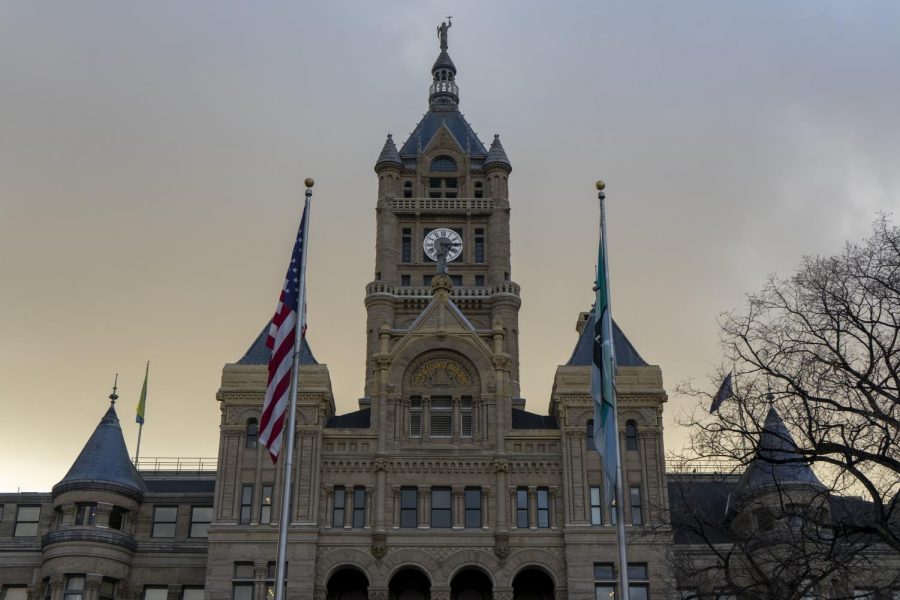Soter: It’s Time for a New Salt Lake Homeless Shelter
The Salt Lake City and County Building located in downtown Salt Lake City. (Photo by Jalen Pace | Daily Utah Chronicle)
April 20, 2021
Salt Lake City Mayor Erin Mendenhall has been in office since early 2020, and decreasing homelessness has been at the center of her agenda. Thanks to a growing population and an economic crisis, that task is proving especially challenging. Still, Mendenhall has put the city on the right track in more ways than one by trying to tackle the systemic, underlying issues that lead to homelessness rather than merely putting a band-aid on the gushing wound.
That said, band-aids exist for a reason. If a kid trips over a pothole in the middle of the street and needs stitches, it’s important to get the kid stitches. It’s important to fix the pothole. It’s also important to put a band-aid over the stitches for a certain amount of time to ensure the wound will heal. The way I see it, we should approach homelessness much in the same way.
Obviously, we need to fix the pothole: figure out what resources people need and provide access to those resources through policy and programming. But first, we need to get the wound stitched up: get a roof over the victim’s head and make sure they have food to eat. And, we need to put on the band-aid: ensure the person’s future safety by connecting them to job interviews, housing applications and other resources. Right now, the city is rightfully focused on long-term solutions to homelessness, but it’s neglecting to treat its symptoms in individual lives. Instead of continuing this way, Mendenhall and her team need to address all three elements that perpetuate the issue of homelessness. Sewing up the wound should come first, or at least simultaneously with long-term planning. For people who are experiencing homelessness today, Salt Lake needs adequate space to ensure they will have access to the other resources the state supplies. A new shelter might just be the solution.
In January 2020, the Rio Grande Road Home was torn down. In its wake, the city implemented a new system to tackle homelessness through the establishment of three much smaller resource centers. The goal of the resource centers was to provide long-term care — job trainings, affordable housing, substance abuse treatment and mental health services — to Salt Lake’s unhoused population while simultaneously putting an end to the toxicity of “Operation Rio Grande,” which resulted in the arrests of many homeless citizens for small misdemeanors and provided no real solution to the bigger problems they were facing. With the resource centers addressing the causes, short-term homelessness would become rare — so the scant number of beds the resource centers provided would be sufficient.
Unfortunately, the well-intentioned plan wasn’t as successful as public leaders imagined. The winter months after the Road Home’s closure were bleak for the homeless community, and many were left on the frozen streets due to inadequate shelter space. The problem became so dire that an emergency shelter was set up in Sugar House’s Deseret Industries warehouse, and even then, many were forced to sleep on snow-covered park benches. The effects of Salt Lake City’s limited short-term space only intensified this past winter with the COVID-19 pandemic. The three resource centers had to cap their already-low occupancy and minimize the spread of the virus among the staff and occupiers, which was a near-impossible task. As a result, a majority of Salt Lake’s ever-growing unhoused community determined it would be safer to remain on the streets than enter a shelter, so that’s what they did. But the group campouts throughout streets and public spaces became just as unsafe when authorities began camp clean-ups, which left many not only without a home but without their belongings like tents, sleeping bags and clothes, all of which helped maintain the slight stability the community had worked so hard to obtain.
In a meeting last month with the Salt Lake Tribune editorial board, Mendenhall confessed that she believes there is a need for a new homeless shelter, perhaps now more than ever. This makes it clear — until the city can stabilize itself and its unhoused constituents in a guaranteed and efficient way, a new shelter is absolutely critical. Without it, we’re not taking care of the wound of homelessness.








